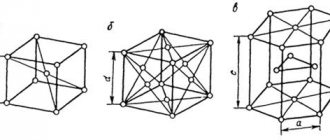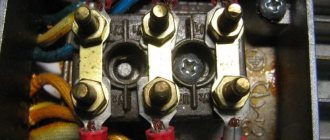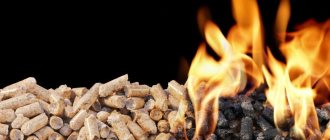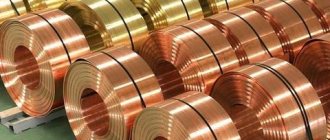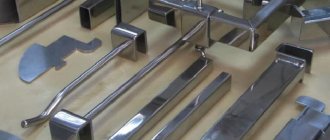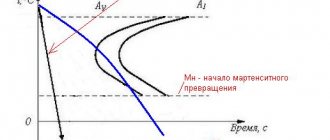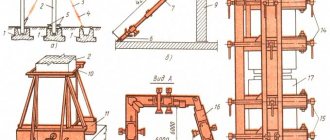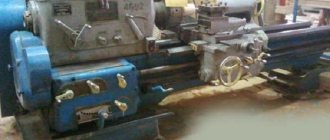Bessemer method
Acid method, the converter lining is made of silica refractory bricks. It is used when melting cast iron grades B1 and B2 into steel, containing a strictly limited (maximum permissible in steels) amount of phosphorus and sulfur. This is explained by the fact that it is impossible to remove harmful S and P impurities in converters or other acid-lined furnaces.
Melting steel in a converter is as follows:
- The converter is placed in a horizontal position.
- Liquid cast iron is poured.
- Air blast is supplied under pressure P = 3÷3.5 atm. (which oxidizes impurities) and at the same time the converter is placed in a vertical position.
During smelting in an acidic converter, 3 periods are observed:
1) Oxidation of Fe, Mn, Si and slag is formed
The oxidation process lasts 3-6 minutes.
2) Carbon burnout, i.e. its oxidation, the liquid boils:
CO escaping from the steel burns out with a bright flame 8-10 meters high
3) The flame stops and brown smoke appears, which means burning of iron, and the smoke itself is particles of iron oxides. It is necessary to quickly stop the air supply and the melting process is over.
If the carbon in the steel remains less than what is required for the grade of steel being smelted, then the C composition is adjusted by adding a small amount of high-carbon cast iron and ferroalloys Fe-Mn, Fe-Si and Al to the steel.
Process planning
It is also fundamentally important to carry out detailed planning of all optimal conditions before each melt. They include:
- consumption of cast iron and scrap;
- level of oxygen supply to the tuyere;
- approximate calculations for the concentration of phosphorus, sulfur and slag;
- analysis of the final steel mass and specified waste volumes.
The specific intensity of steel smelting using the oxygen method in converters makes it possible to produce high volumes of raw materials with minimal load on the process. An important role here is played by the design and selection of accompanying conditions, as well as the organization of production technology.
High-quality steel in the country is produced not only in huge factories, but also in small premises; efficient production requires the necessary power of units and qualified specialists.
Thomas method
The Thomas method involves blowing air through the liquid metal, but the lining is basic and thanks to this it becomes possible to remove phosphorus. Dolomite lining (MgO, CaO). It is used for remelting cast iron grades T-1 and T-2 into steel, containing an increased percentage of phosphorus up to 2.2% and sulfur.
In a Thomas converter, oxidation processes occur in the same sequence as in a Bessemer converter, with the exception that in the third period there is rapid oxidation of phosphorus, due to which the temperature of the steel rises sharply and the steel becomes of higher quality and ductility.
To remove P and S, 12-14% of the weight of the cast iron being poured is loaded into the converter - limestone CaCO3:
P2O5(CaO)4 is a very strong compound and a valuable fertilizer for agriculture.
– FeS + CaO → CaS + FeO, where CaS is a weak compound, so Mn is introduced:
CaS + MnO → MnS + CaO, where MnS – does not go into the bath; if it remains, then it is a more refractory compound than FeS + Fe (tmelt. ≈ 988°C).
At present, the Thomas method is almost never used in our country, since we have few high-phosphorus and high-sulfur ores.
The considered converter methods of steel smelting have the following advantages:
- High productivity (melting time 20-30 min.).
- Simplicity of furnace (converter) designs and therefore low capital costs.
- Low operating costs.
- It is not necessary to specifically introduce heat during melting, since it is obtained in converters due to oxidation reactions of impurities.
- Significant iron loss (up to 13%).
- Inability to melt scrap (metal scrap) in large quantities.
- Lower quality of steel (the main disadvantage of converting) - for example, due to air blowing in the steel, the nitrogen content increases (up to 0.025-0.048%), which significantly reduces the quality of the steel.
- Due to the short duration of the process, it is impossible to smelt steels of complex chemical composition in converters, and due to low temperatures (highest melting temperature = 1600°C), it is impossible to add refractory alloying components (W, Mo, Nb, etc.).
Thus, until now, converter steel production has been limited due to the above-mentioned disadvantages. Only simple carbon steels of ordinary quality were smelted in converters.
Oxygen-converter method of steel production
Currently, the industrial industry has become so strong that it has become possible to produce industrially pure oxygen in large industrial quantities. By blowing oxygen through cast iron, it is possible to smelt steel in it that is close in quality to open-hearth steel. In addition, thanks to the use of O2 in converters, their productivity increases even more and the bath temperature also increases (tmelt. increases to
2500°C), which allows scrap to be melted in larger quantities in converters. Oxygen-converter production has made it possible in recent years to smelt up to 40% of the total amount of steel produced in converters.
Figure 1.2 – Oxygen-converter method:
1 – loading neck, 2 – cylindrical part, 3 – steel ring with pins, 4 – removable bottom
With this method, oxygen is supplied to the liquid cast iron bath in the converter from above, through a water-cooled lance.
Converter units with bottom oxygen-fuel blowing are 1.5 times more productive than a 2-bath open-hearth furnace (while maintaining the balance of scrap metal).
The leading principles of high-quality steel smelting
According to statistical indicators, every tenth ton of steel produced in the world is obtained as a result of the oxygen-converter method with bottom blowing.
The entire process, with low production costs and adequate working conditions, contributes to the production of high-quality steel. The unique technological capabilities of converter units allow the use of various alloy compositions, except for the liquid cast iron itself.
A certain interest in this method in industry is caused by its widespread use since the 60s of the last century. The main standard range of containers for converter units was established during the Soviet Union. The huge vessels are pear-shaped and have a volume range from 50 to 400 tons.
It should be noted that it is the size of the converter that influences the improvement of finished steel performance. The optimal specific volume of the oxygen converter promotes an intensive supply of oxygen and prevents emissions of foaming slags and metals.
One of the leading principles for the production of steel in oxygen converters is their design with a capacity of 400 to 4.3 thousand tons and a minimum height of 6–8 meters. Units that are too low provoke emissions of foaming metal through narrow necks. This fact negatively affects the entire production process and the quality of the output steel itself.
Bessemer method
Acid method, the converter lining is made of silica refractory bricks. It is used when melting cast iron grades B1 and B2 into steel, containing a strictly limited (maximum permissible in steels) amount of phosphorus and sulfur. This is explained by the fact that it is impossible to remove harmful S and P impurities in converters or other acid-lined furnaces.
Melting steel in a converter is as follows:
- The converter is placed in a horizontal position.
- Liquid cast iron is poured.
- Air blast is supplied under pressure P = 3÷3.5 atm. (which oxidizes impurities) and at the same time the converter is placed in a vertical position.
During smelting in an acidic converter, 3 periods are observed:
1) Oxidation of Fe, Mn, Si and slag is formed
The oxidation process lasts 3-6 minutes.
2) Carbon burnout, i.e. its oxidation, the liquid boils:
CO escaping from the steel burns out with a bright flame 8-10 meters high
3) The flame stops and brown smoke appears, which means burning of iron, and the smoke itself is particles of iron oxides. It is necessary to quickly stop the air supply and the melting process is over.
Thomas method
The Thomas method involves blowing air through the liquid metal, but the lining is basic and thanks to this it becomes possible to remove phosphorus. Dolomite lining (MgO, CaO). It is used for remelting cast iron grades T-1 and T-2 into steel, containing an increased percentage of phosphorus up to 2.2% and sulfur.
In a Thomas converter, oxidation processes occur in the same sequence as in a Bessemer converter, with the exception that in the third period there is rapid oxidation of phosphorus, due to which the temperature of the steel rises sharply and the steel becomes of higher quality and ductility.
To remove P and S, 12-14% of the weight of the cast iron being poured is loaded into the converter - limestone CaCO3:
P2O5(CaO)4 is a very strong compound and a valuable fertilizer for agriculture.
– FeS + CaO → CaS + FeO, where CaS is a weak compound, so Mn is introduced:
CaS + MnO → MnS + CaO, where MnS – does not go into the bath; if it remains, then it is a more refractory compound than FeS + Fe (tmelt. ≈ 988°C).
At present, the Thomas method is almost never used in our country, since we have few high-phosphorus and high-sulfur ores.
The considered converter methods of steel smelting have the following advantages:
- High productivity (melting time 20-30 min.).
- Simplicity of furnace (converter) designs and therefore low capital costs.
- Low operating costs.
- It is not necessary to specifically introduce heat during melting, since it is obtained in converters due to oxidation reactions of impurities.
- Significant iron loss (up to 13%).
- Inability to melt scrap (metal scrap) in large quantities.
- Lower quality of steel (the main disadvantage of converting) - for example, due to air blowing in the steel, the nitrogen content increases (up to 0.025-0.048%), which significantly reduces the quality of the steel.
- Due to the short duration of the process, it is impossible to smelt steels of complex chemical composition in converters, and due to low temperatures (highest melting temperature = 1600°C), it is impossible to add refractory alloying components (W, Mo, Nb, etc.).
Thus, until now, converter steel production has been limited due to the above-mentioned disadvantages. Only simple carbon steels of ordinary quality were smelted in converters.
Oxygen-converter method of steel production
Currently, the industrial industry has become so strong that it has become possible to produce industrially pure oxygen in large industrial quantities. By blowing oxygen through cast iron, it is possible to smelt steel in it that is close in quality to open-hearth steel. In addition, thanks to the use of O2 in converters, their productivity increases even more and the bath temperature also increases (tmelt. increases to
2500°C), which allows scrap to be melted in larger quantities in converters. Oxygen-converter production has made it possible in recent years to smelt up to 40% of the total amount of steel produced in converters.
Figure 1.2 – Oxygen-converter method:
1 – loading neck, 2 – cylindrical part, 3 – steel ring with pins, 4 – removable bottom
With this method, oxygen is supplied to the liquid cast iron bath in the converter from above, through a water-cooled lance.
Converter units with bottom oxygen-fuel blowing are 1.5 times more productive than a 2-bath open-hearth furnace (while maintaining the balance of scrap metal).
Oxygen converter
Three well-established technological processes are used to produce steel: open-hearth, oxygen-converter, and electric melting. According to statistics, the largest amount of steel in the world is smelted using an oxygen converter. It accounts for more than 70% of all steel produced.
The basics of this method were developed in the early thirties of the twentieth century. They began to use it at Austrian factories located in the two cities of Linz and Donawitz only in the fifties of the twentieth century. In foreign technical literature on metallurgy, this method of producing steel is called LD. This name arose from the first letters of Austrian cities. Our metallurgists call it oxygen converter.
